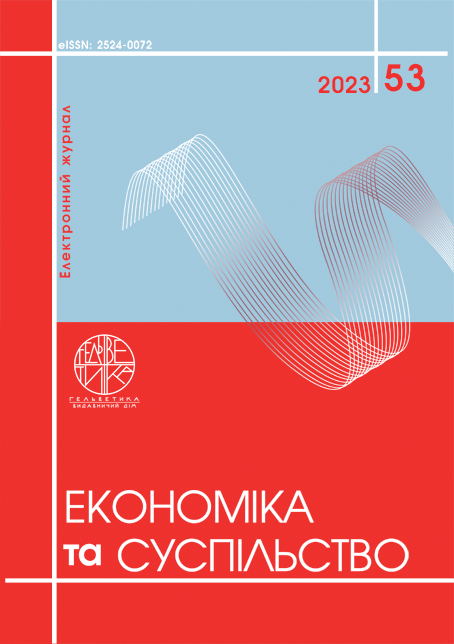SOCIO-ECONOMIC ASPECTS OF THE ELECTRICITY GENERATION DEVELOPMENT IN HOUSEHOLDS OF UKRAINE AND THE EU
Abstract
In recent years, the need to transform the electric power sector in the direction of digitalization and the transition to sustainable development has become much more urgent. The purpose of the article is to consider the main trends in the development of the electric power industry in Ukraine and the EU, to carry out a corresponding comparative analysis at the level of households. The study revealed the main trends in electricity consumption in Ukrainian and EU households. It was found that electricity consumption in our country is one of the lowest among the analyzed neighboring countries and is significantly lower than the European average. Factors affecting the change in electricity consumption are identified: energy efficiency, introduction of renewable energy sources and reforms in the energy sector. A comparative analysis of electricity prices for households in European countries was carried out, which testified to significant differences in the level of tariffs and the pricing structure. The basic forecasts regarding the volumes of electricity consumption in Ukrainian households in the post-war period are considered. According to the positive scenario, the recovery of the economy and the increase in the standard of living of the population are expected. Provided that investments are attracted, a positive trend towards the growth of electricity consumption due to the growth of aggregate demand is predicted. The negative scenario is a long-term post-war recession, slow growth of population welfare and restoration of generating capacities. At the same time, it is difficult to predict the consumption of electrical energy in the post-war period due to migration processes and the demographic structure of the population. Recommendations are provided for improving the state of the energy industry at the micro level. In particular, to create a reliable energy system built on the basis of households, first of all, it is recommended to create a solvent demand among the population and economically favorable conditions for the construction of private solar and wind energy sources.
References
Sotnyk I., Kovalenko Y., Chortok Y., Kripak Y. Prospects of Investment in Green Energy Projects in Ukrainian Households. Economics and Region. 2019. Vol. 2(73). P. 12–21. DOI: https://doi.org/https://doi.org/10.26906/еір.2019.2(73).1621
Кочешкова І.М. Енергетична бідність в країнах ЄС та Україні. Вісник економічної науки України. 2019. № 2 (37), С. 48–55.
Energy Community Association. URL: https://ua-energy.org/uk/posts/13-18-pobutovykh-spozhyvachiv-ukrainy-ie-enerhetychno-bidnymy-doslidzhennia
Haas, R., Panzer, C., Resch, G. et al. (2011). A historical review of promotion strategies for electricity from renewable energy sources in EU countries. Renewable and Sustainable Energy Reviews. 2011. Vol. 15. P. 1003–1034.
Liu, S., Colson, G., Hao, N., & Wetzstein, M. (2018). Toward an optimal household solar subsidy: a social-technical approach. Energy. 2018. Vol. 147. P. 377–387.
Jacobs D., & Sovacool B. (2012). Feed-in tariffs and other support mechanisms for solar PV promotion. Renewable Energy. 2012. Vol. 1. P. 73–109.
Сотник І.М. Організаційно-економічні проблеми і перспективи розвитку відновлювальної енергетики у приватних домогосподарствах України. Економічний форум. 2018. № 3. С. 47–56.
Kurbatova T.O. Economic benefits for producers of biogas from cattle manure within energy co-operatives in Ukraine. International Journal of Sustainable Energy Planning and Management. 2018. № 18. P. 69–80.
Chwieduk, D., & Chwieduk, M. Determination of the energy performance of a solar low energy house with regard to aspects of energy efficiency and smartness of the house. Energie. 2020. Vol. 13(12). P. 3232. DOI: https://doi.org/10.3390/en13123232
НКРЕКП: офіційний веб-сайт. URL: https://www.nerc.gov.ua/sferi-diyalnosti/elektroenergiya/naselennya/serednye-spozhivannya-elektroenergiyi-pobutovimi-spozhivachami
Davis, L. W., & Metcalf, G. E. (2017). Time-of-Use Electricity Pricing and Residential Energy Consumption. American Economic Review. 2017. Vol. 107(7). P. 196–200.
Halynska Y., Bondar T., Yatsenko V., Oliinyk V. Combined model of optimal electricity production: Evidence from Ukraine. Polityka Energetyczna. 2022. Vol. 25(1). P. 39–58.
НКРЕКП: офіційний веб-сайт. Заходи з енергозбереження у сфері електропостачання. URL: https://www.nerc.gov.ua/sferi-diyalnosti/elektroenergiya/promislovist/zahodi-z-energozberezhennya-u-sferi-elektropostachannya
Міністерство енергетики України (2023). URL: https://www.mev.gov.ua/storinka/diyalnist
Скільки платять за електроенергію жителі ЄС у 2023 році: порівняння тарифів з українськими. URL: https://www.slovoidilo.ua/2023/03/06/infografika/ekonomika/skilky-platyat-elektroenerhiyu-zhyteli-yes-2023-roczi-porivnyannya-taryfiv-ukrayinskymy
Sotnyk I., Kovalenko Y., Chortok Y., Kripak Y. (2019) Prospects of Investment in Green Energy Projects in Ukrainian Households. Economics and Region, 2(73): 12–21. DOI: https://doi.org/https://doi.org/10.26906/еір.2019.2(73).1621
Kocheshkova I.M. (2019) Enerhetychna bidnist v krainakh YeS ta Ukraini. Visnyk ekonomichnoi nauky Ukrainy, 2 (37): 48–55.
Energy Community Association. Available at: https://ua-energy.org/uk/posts/13-18-pobutovykh-spozhyvachiv-ukrainy-ie-enerhetychno-bidnymy-doslidzhennia
Haas, R., Panzer, C., Resch, G. et al. (2011). A historical review of promotion strategies for electricity from renewable energy sources in EU countries. Renewable and Sustainable Energy Reviews, 15: 1003–1034.
Liu, S., Colson, G., Hao, N., & Wetzstein, M. (2018). Toward an optimal household solar subsidy: a social-technical approach. Energy, 147: 377–387.
Jacobs D., & Sovacool B. (2012). Feed-in tariffs and other support mechanisms for solar PV promotion. Renewable Energy, 1: 73–109.
Sotnyk, I.M. (2018). Orhanizatsiino-ekonomichni problemy i perspektyvy rozvytku vidnovliuvalnoi enerhetyky u pryvatnykh domohospodarstvakh Ukrainy. Ekonomichnyi forum, 3: 47–56.
Kurbatova T.O. (2018) Economic benefits for producers of biogas from cattle manure within energy co-operatives in Ukraine. International Journal of Sustainable Energy Planning and Management, 18: 69–80.
Chwieduk, D., & Chwieduk, M. (2020). Determination of the energy performance of a solar low energy house with regard to aspects of energy efficiency and smartness of the house. Energies, 13(12): 3232. DOI: https://doi.org/10.3390/en13123232
NKREKP: ofitsiinyi veb-sait. Available at: https://www.nerc.gov.ua/sferi-diyalnosti/elektroenergiya/naselennya/serednye-spozhivannya-elektroenergiyi-pobutovimi-spozhivachami
Davis, L. W., & Metcalf, G. E. (2017). Time-of-Use Electricity Pricing and Residential Energy Consumption. American Economic Review, 107(7), 196–200.
Halynska Y., Bondar T., Yatsenko V., Oliinyk V. (2022) Combined model of optimal electricity production: Evidence from Ukraine. Polityka Energetyczna, 25(1), 39–58.
NKREKP: ofitsiinyi veb-sait. Zakhody z enerhozberezhennia u sferi elektropostachannia. Available at: https://www.nerc.gov.ua/sferi-diyalnosti/elektroenergiya/promislovist/zahodi-z-energozberezhennya-u-sferi-elektropostachannya
Ministerstvo enerhetyky Ukrainy (2023). Available at: https://www.mev.gov.ua/storinka/diyalnist
Skilky platiat za elektroenerhiiu zhyteli YeS u 2023 rotsi: porivniannia taryfiv z ukrainskymy. Available at: https://www.slovoidilo.ua/2023/03/06/infografika/ekonomika/skilky-platyat-elektroenerhiyu-zhyteli-yes-2023-roczi-porivnyannya-taryfiv-ukrayinskymy

This work is licensed under a Creative Commons Attribution 4.0 International License.


